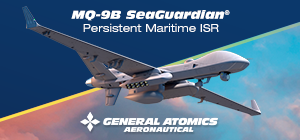
The recently installed new First Sea Lord, first ever Royal Marine to hold the rank, Sir Gwyn Jenkins, used DSEI to set out a very ambitious timeline of innovation for the Royal Navy which includes the “aim to have the first of our uncrewed escort ships sailing alongside our RN warships within the next 2 years”.
Unsurprisingly, industry has been putting forward concepts for optionally manned, or even fully autonomous, vessels in order to be ready for this ask. Known Royal Navy plans for large, uncrewed surface vehicles include a “Type 92 Sloop” to be used primarily within wider Anti Submarine Warfare surveillance within Project CABOT/ATLANTIC BASTION for an autonomous “ASW barrier” in the North Atlantic; and a prospective Type 91 arsenal ship that will bring additional Vertical Launch cells and sensors for the Anti Air Warfare missions.
Early Requests For Information (RFI) have looked at modular payloads for hulls in the region of the 40 m, the rough size of the experimental vessel XV PATRICK BLACKETT which is expected to soon test Autonomy Level 4, having already been fitted with an Artificial Intelligence core.
Faced with the challenge of building a ship large enough to contribute meaningfully to the Navy’s missions while being cheap and extremely lean crewed and/or entirely autonomous at least for periods of its cruises, BAE Systems has looked back to the past and identified the experimental vessel TRITON as a good starting point. Ordered in 1998, the Research Vessel TRITON was built by then Vosper Thornycroft at a cost of £13.5m to de-risk a trimaran hull form that was of interest to both the Royal Navy (in the context of what was then known as Future Surface Combatant) and to the US Navy.
At 97 m of length and 22,45 of beam m for over 2200 tons, the TRITON has a diesel electric propulsion with a single shaftline that can drive her at up to 20 knots, with a range of over 3000 nautical miles. She had a crew of as few as 14.
BAE Systems’s concept has her original design externally almost unchanged, with the stern area turned into a working deck capable of embarking 40-feet containers for a towed sonar array and or for the launch and recovery of drones. In the model showcased, one of the containers is shown hosting a HERNE XLUUV, also by BAE Systems, although it’s not immediately clear how the large uncrewed submarine would be launched and recovered.
The small superstructure is topped by a mast carrying an “ARTISAN Next Gen” radar as main sensor. This new radar with turning head is understood to be in development, also thanks to a contract for the development of new maritime radar awarded by the MoD to BAE back in July. No detail is currently available about intended performances, but the sensor head is much larger than that of the current ARTISAN 3D/Type 997 and very possibly integrates more than one fixed face within the new rotodome (much like the much larger SAMPSON which has 2 large flat arrays positioned back to back within its spherical rotodome).
The USV model shows 32 Mk-41 cells in a long arrangement over the bow with the cells arranged in blocks of 4 (2 rows of 2 with a central exhaust vent) but BAE spokespersons note that it’s early days and not too much attention should be paid to such detail, still subject to change.
One (probably more) likely alternative would be the use of the Adaptable Deck Launcher also by BAE Systems, already proposed for the US Navy’s own USV projects as well as due for adoption aboard US Navy carriers and amphibious ships as a replacement for the trainable box launchers for SEA SPARROW/ESSM.
The Adaptable deck launcher, non hull-penetrating, uses Mk-41 canisters lowered on their side in inclined above-deck mounts.
Video overlays showed the large flight deck in use to land helicopters and large drones and also showed davits for RHIBs and boats on each side as well as 2 BAE-Bofors Mk4 gun turrets as close range armament. With 3P programmable ammunitions, these guns are powerful close-in solutions, good against surface and air targets in all circumstances.

As for the Type 83 proposal (picture below), the early concept put forward by BAE Systems is clearly derived from the Type 26 “Strike” already proposed to Australia with the replacement of the mission bay amidship with a second silo for missiles. The video overlay showed a total of 128 VLS cells (bow and amidship silos, each with 8 MK41 modules with 8 cells each).
As indicated in the general requirements outlined by the Royal Navy, the proposed destroyer has a Mk57 57mm gun rather than a 5-inch, and 40 mm Mk 4 turrets as secondaries (as found on the Babcock-built Type 31 frigates, but with the 40 mm on sponsons on either side of the hangar as on the Type 26 – which however will have 30 mm mounts, at least initially). The ship is also shown fitted with 3 laser weapons (DRAGONFIRE, in the CGI), one on the bow and one on either side, amidship, replacing the PHALANX mounts planned for the Type 26.
The concept is dominated by a massive mainmast with large fixed face radar arrays. BAE cautions that this is only indicative of the direction of travel, at present: the shapes and specifics are by no means definitive. It is expected that the new radar will evolve and upscale the antennas of the SAMPSON radar that currently equips the Type 45, but again we are in (relative) early days for the project.
The UK has also reiterated in the recent “50 years AUKUS treaty” with Australia the intent to evaluate the use of the Australian CEAFAR radar technology as a potential solution and BAE had an alternative CGI overlay showing a mainmast clearly hosting a massive CEAFAR 2 installation with its multiple fixed faces.









.png)
